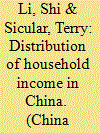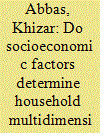|
|
|
Sort Order |
|
|
|
Items / Page
|
|
|
|
|
|
|
| Srl | Item |
| 1 |
ID:
166927


|
|
|
|
|
| Summary/Abstract |
The upward trend in the residential sector of energy use has significant consequences in terms of environmental impacts. Determining the carbon metric (CM), as part of the whole carbon footprint of a building, contributes to quantify the carbon emissions related to the building's use stage. Although many carbon footprint calculators exist in other sectors, none has been specifically designed and applicable to the building one. However, ISO 16745 provides guidelines for calculating and reporting the CM of existing buildings in operation. In this context, this work sets a methodology to measure the CM of existing households' use stage, based on ISO 16745 and split into three stages. The implementation of the methodology to a case study proved its applicability since it enabled the data collection task through the designed survey, and allowed the energy carriers and end-uses be disaggregated, quantified and clearly reported for user's knowledge. The study outlined that calculating the CM and, more specifically, reporting and making the results publicly available, help raise users' awareness about reducing greenhouse gas-related emissions, and provide new ideas for monitoring, benchmarking and proposing policies at individual member state and EU levels.
|
|
|
|
|
|
|
|
|
|
|
|
|
|
|
|
| 2 |
ID:
136208


|
|
|
|
|
| Summary/Abstract |
A comprehensive survey of 1450 households in 26 Chinese provinces was undertaken in 2012 to identify the characteristics and potential driving forces of residential energy consumption in China. The survey covers six areas: household characteristics, dwelling characteristics, kitchen and home appliances, space heating and cooling, residential transportation, and electricity billing, metering, and pricing options. The results show that a typical Chinese household in 2012 consumed 1426 kilograms standard coal equivalent, which is approximately 44 percent of the 2009 level in the United States and 38 percent of the 2008 level in the EU-27. District heating, natural gas, and electricity are three major residential energy sources, while space heating, cooking, and water heating are three major end-use activities. Moreover, the results suggest a large urban–rural gap in terms of energy sources and purpose of usage. Commercial energy is used mainly for space heating in urban areas, while biomass dominates mainly for cooking purpose in rural areas. The survey results can help decision makers and scholars identify energy conservation opportunities, and evaluate the effectiveness of energy policies.
|
|
|
|
|
|
|
|
|
|
|
|
|
|
|
|
| 3 |
ID:
131947


|
|
|
|
|
| Publication |
2014.
|
| Summary/Abstract |
Income Theory
Public Distribution
China
Chinese Economy
Poverty
Politics
Social Reforms
Inequality
Gini Sufficient
Household Survey
Distribution Theory
Distribution Politics
Development Strategy
International Standard
Urbanization
Urban Poverty
Rural Poverty
|
|
|
|
|
|
|
|
|
|
|
|
|
|
|
|
| 4 |
ID:
175246


|
|
|
|
|
| Summary/Abstract |
This paper examines the socioeconomic factors of energy poverty at the household level using a dataset of 674,834 households from six South Asian countries. An adjusted multidimensional energy poverty index (MEPI) is used to measure the extent and depth of energy poverty, and a Tobit model is employed to examine the significance of socioeconomic status for multidimensional energy poverty. An ordinary least squares (OLS) regression model is compared with the results of the Tobit model, using the combined dataset and the datasets for each country separately. House size, household wealth, education, occupation (clerical, sales, or agricultural), and gender of the head of the households are significant negative socioeconomic determinants of household multidimensional energy poverty. Place of residence, house ownership status, family size, and the age of the primary breadwinner play a significant positive role in multidimensional energy poverty. These results suggest that effective policy measures for improving the socioeconomic status of households will mitigate multidimensional energy poverty. With implications for the design and implementation of policy, the evidence-based results of this study will contribute to reducing the detrimental impacts of multidimensional energy poverty nationally, regionally, and globally.
|
|
|
|
|
|
|
|
|
|
|
|
|
|
|
|
| 5 |
ID:
174953


|
|
|
|
|
| Summary/Abstract |
Air conditioning (AC) is a major source of household electricity consumption in Singapore and there is evidence that the efficiency of ACs could be improved substantially. Employing 45 months of energy bills and survey data and the Fixed Effects difference-in-differences estimator, we calculated a savings of 7.8% of total energy consumption after the purchase of a more efficient AC compared to an estimated expected savings of 12.6%. This suggests a rebound or take-back of savings around 38.2%. Such a less-than-100% of theoretical savings achieved is in line with other (outside Singapore) estimates and economic/behavioural theory since after purchasing a new AC, households may (i) use a lower temperature setting or (ii) use the AC longer in order to (1) fulfil (previously) unmet demand and/or (2) respond to the effective lower costs of running the AC. Our results have implications for both energy efficiency labelling policies and for Singapore's recently implemented carbon tax.
|
|
|
|
|
|
|
|
|
|
|
|
|
|
|
|
| 6 |
ID:
150360


|
|
|
|
|
| Summary/Abstract |
As part of a programme on ‘access to clean cooking alternatives in rural India’, induction stoves were introduced in nearly 4000 rural households in Himachal Pradesh, one of the few highly electrified states in India. Analysis of primary usage information from 1000 rural households revealed that electricity majorly replaced Liquid Petroleum Gas (LPG), generally used as a secondary cooking fuel, but did not influence a similar shift from traditional mud stoves as the primary cooking technology. Likewise, the shift from firewood to electricity as a primary cooking fuel was observed in only 5% of the households studied. Country level analysis indicates that rural households falling in lower monthly per capita expenditure (MPCE) classes have lesser access to electricity and clean cooking options than those falling in higher MPCE classes. Again, only three states in India with high levels of rural household electrification report consumption statuses more than 82 kWh per month (the estimated mean for electricity consumption by induction stoves). Overall, the results of the study indicate that induction stoves will have limited potential in reducing the consumption of firewood and LPG if included in energy access programmes, that too only in regions where high levels of electrification exist.
|
|
|
|
|
|
|
|
|
|
|
|
|
|
|
|
| 7 |
ID:
166734


|
|
|
|
|
| Summary/Abstract |
Inability or insufficient access to modern forms of energy is an important issue in development, which makes the notion of energy poverty a widely discussed topic. A consensus has been reached that energy poverty has serious health, education, and other socio-economic impacts for people in a country. However, measurements of energy poverty have generally been absent or inaccurate, especially for developing countries at the micro level. This paper begins with the multidimensional nature of energy poverty and uses household-level survey data in China to construct a quantitative measure of energy poverty, covering both affordability of and accessibility to a broad range of forms of energy. It then builds an econometric model to address empirically how much energy poverty affects health. A statistically significant and robust negative impact on health from energy poverty is confirmed. Our results have important policy relevance in terms of understanding the current status quo of energy poverty in China and its consequences. The concept can also be expanded to investigate similar issues in other developing countries.
|
|
|
|
|
|
|
|
|
|
|
|
|
|
|
|
| 8 |
ID:
159761


|
|
|
|
|
| Summary/Abstract |
Poverty targeting plays an important role in ensuring the success of support programs for the poor. We assess the governmental poverty targeting in Vietnam, which identifies poor households by collecting income data using a simple two-page questionnaire. We propose a proxy means tests (PMT) method to predict income and poverty status of households using data on basic household characteristics. Compared with the poverty targeting using the simple income questionnaire, the PMT method has higher coverage and lower leakage rates. In addition, the proposed approach also allows for more transparent and comparable poverty estimation across small areas in Vietnam.
|
|
|
|
|
|
|
|
|
|
|
|
|
|
|
|
|
|
|
|
|